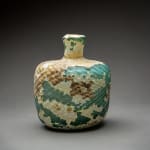Islamic Glass Bottle, 800 CE - 900 CE
Mold Blown/Tooled Glass
11.9 x 9.9 cm
4 3/4 x 3 7/8 in
4 3/4 x 3 7/8 in
JB.1096
The glass industry in the Early Islamic Period can initially be characterized as a continuation of older traditions. Following the rise of the Abbasid Caliphate in AD 750, the capital...
The glass industry in the Early Islamic Period can initially be characterized as a continuation of older traditions. Following the rise of the Abbasid Caliphate in AD 750, the capital of the Islamic world was moved from Levantine Damascus to Baghdad in Mesopotamia. This led to a cultural shift away from the influences of Classical traditions, and allowed for the development of an more pure Islamic expression. The iridescence on ancient glass was unintentional, unlike what is found on modern Tiffany, Loetz and Steuben glass. Caused by weathering on the surface, the iridescence and the interplay of lustrous colors, is due to the refraction of light by thin layers of weathered glass. How much a glass object weathers depends mainly on its burial conditions and to a lesser extent to the chemical components it was made of. Iridescence may also be conditioned by humidity, heat and the type of soil the glass was buried in.



